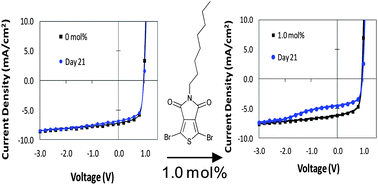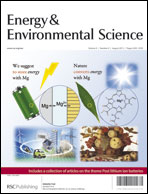Improving the long-term stability of PBDTTPD polymer solar cells through material purification aimed at removing organic impurities†
Abstract
While bulk heterojunction (BHJ) solar cells fabricated from high Mn PBDTTPD achieve power conversion efficiencies (PCE) as high as 7.3%, the short-circuit current density (JSC) of these devices can drop by 20% after seven days of storage in the dark and under inert conditions. This degradation is characterized by the appearance of S-shape features in the reverse bias region of current–voltage (J–V) curves that increase in amplitude over time. Conversely, BHJ solar cells fabricated from low Mn PBDTTPD do not develop S-shaped J–V curves. However, S-shapes identical to those observed in high Mn PBDTTPD solar cells can be induced in low Mn devices through intentional contamination with the TPD monomer. Furthermore, when high Mn PBDTTPD is purified via


 Please wait while we load your content...
Please wait while we load your content...